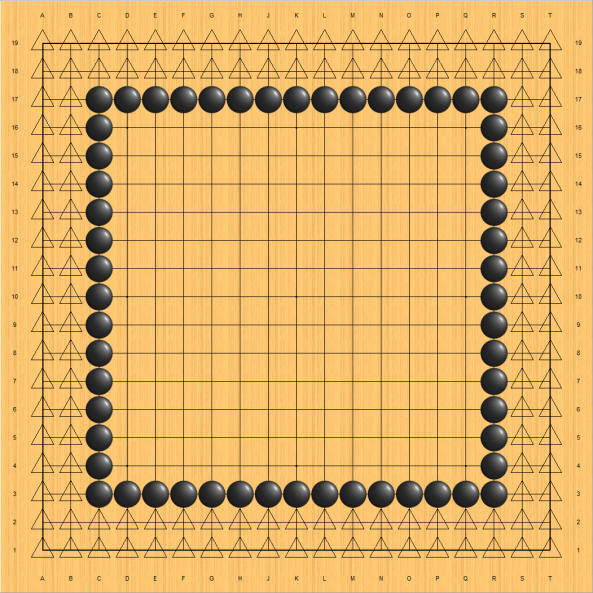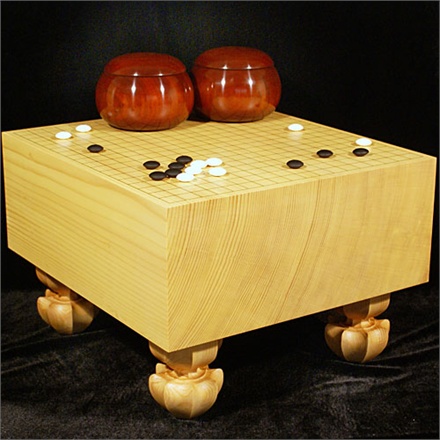The size of a go board has gone through many changes, from 9×9 to 15×15 to 17×17 and then finally to 19×19. Actually no matter what the size is, a proper game of Go can be played. It can even be enlarged to 21×21 or 23×23. Why then, is it that it stops at 19×19?
This is actually related to the idea of balance. As we all know, on a go board, the 3rd line is the territory line, while the 4th line is influence line. If we want to get all the points on the 3rd line and below, we need 56 stones, and get 136 points in total. If we want to get all the points in the centre on the 4th line and above, we need 48 stones, and can get 121 points in total.

56 stones to get 136 Points in the sides and corners
48 stones to get 121 points in the centre
Taking the average number of points per stone:
136/56 = 2.4286 (For the sides and corners)
121/48 = 2.5208 (For the centre)
The difference between the two values is 0.09 points, which is almost negligible. This means that the efficiency of the stones on the 3rd line and those on the 4th line are almost the same.
If the size of a go board gets bigger or smaller, it will lead to imbalance between territory and influence. The value of the centre will the different from that of the sides and corners.
That is the reason why the size of a board remains at 19×19.


Pingback: Do you know why a Go Board is 19×19? | Dr Silvia Lozeva
I believe the author is using functionalist reasoning without backing up his/her assertions with cultural or historical facts. I doubt the evolution of the board size was driven purely by this reasoning.
If reasening surely needed in evolution why our body for example is working so effective? I don’t think reasening is nessary to find over 1000 of years a balance. It can just come from the “feeling of playling”.
I guess you have the right reason to doubt. the reasoning of board size balance may be one of the evolution.
very interesting, thks for sharing!!
Pingback: Balance | Easy Go
I think the board’s size has more to do with the game’s initial astrological connotations (19 x 19 = 361 which is approximately the number of days in a year) than with the balance between territory and influence. However, as it turns out, 19 x 19 is a very good size precisely for those balance reasons stated in the article. Also, one can complete a game in a reasonable amount of time (ever tried to play 38 x 38 on KGS?) : )
That’s an interesting explanation as well. I kept thinking why 19×19 is so close to the numbers of days in a year! It made me quite confused sometimes 🙂
Interesting ideas here… and a good beginning to some investigation, but see the next page (about Balance) and my comments there for some deeper analysis.
one story that I know from my beginings of playng go is like this> there is one point for every day of the year and in the center point is the universe, because ancient chinese people had one year of 360 days. Another thing about go is that you canot play go on boards with even number of points because the total number of points has to be un-even.
4u2go, Actually it is possible to play the game of Go on a board with an even number of points. My friend Stig made a 12×12 GoBan and we played on it… it has no tengen point, but a good game can be had. 🙂
Reblogged this on My Cat Plays Baduk and commented:
I think that a 19×19 board definitely is the perfect size, though it personally seems more like something that evolved out of tradition. In this maybe it is happy coincidence that the board evolved to the perfect size?I’m not sure, old boards in Chinese were found 17×17, which still seems like a great size
I gotta say you misunderstood this culture.
Go or Weiqi, was invented by Chinese.
If you ever read “棋經十三篇”, you’ll know why.
夫萬物之數,從一而起。局之路,三百六十有一→The count of number is from 1. The point of board is 361.
一者,生數之主,據其極而運四方也。三百六十,以象周天之數→”1″ means the start, and 360 means the days of a year(周天之數).
Chinese prefer the number of 9, they thought “9” is universe, emperor. So “九天(9 dimensions) means universe, and “九五(95)” means emperor.
The Chinese chess is 9*10. The Mahjong created by Chinese, Money-suited cards are from 1-9.https://en.wikipedia.org/wiki/Mahjong#/media/File:%E6%B2%AD%E9%99%BD%E7%B4%99%E7%89%8C.png
May we publish this article in German on go-baduk-weiqi.de?
Hi therben! Sure, go ahead! 🙂